 topThe Chandler &
Price "Gordon" Press topThe Chandler &
Price "Gordon" Press
The C&P Gordon is
probably the most common platen press found in
America today - as has been the case since Mr.
Chandler & Mr. Price formed the company to
manufacture the platen press designed, not by
G.P. Gordon, but by Hentry Thorpe of the
Cincinnatti Type Foundry around 1888.
Mr. Thorpe sold these presses as the "Thorpe
Gordon" for only two years, passing on the
market to Chandler & Price and falling into
obscurity as the name chosen by C&P to
market this press was the better known name
"Gordon".
C&P made the "Early Series" press as shown
here from 1888 through 1914, having introduced
their "New Series" presses in all sizes by 1914.
The main visible difference can be seen in the
spokes of the flywheel; curved spokes came
first, but were replaced by straight spokes
beginning in 1912 on some models, and on all
models by 1914.
These presses also came equipped with Full or
Pony Ink fountains, that would assure consistent
inking throughout a long press run.
Although unskilled hand feeders should keep to
approx 10-15 impressions per minute, these
presses, when new would often be run as quickly
as 30 impressions per minute.
These presses also came equipped with
foot-operated treadles, but could also be driven
via line shaft or electric motors.
top
The Challenge
"Gordon" Press
Challenge Machinery Company also built a
"Gordon" press and capitalized on the popularity
of Mr. Gordon's reputation.
Although a solid company, Challenge was unable
to overcome C&P's marketing and the
advantages of their Thorpe-designed press, so
these presses are far less likely to be found
these days - but in 1897 were certainly trying
to be the front runner.
This press never became as popular as Gordon's
press or C&Ps, but Challenge Machinery
continued to be a major producer of all sorts of
print shop equipment.
top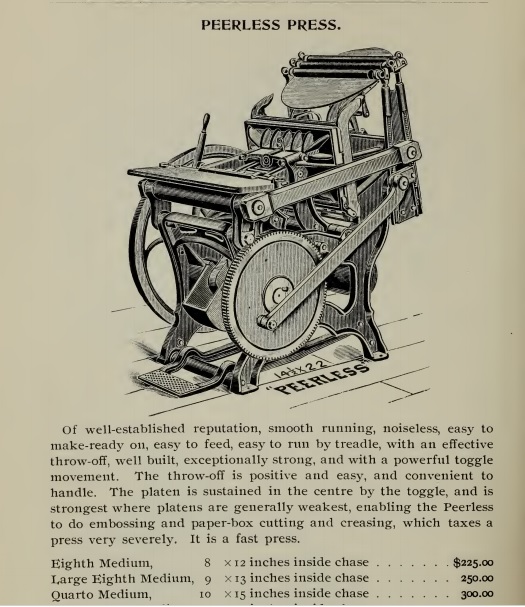 The Peerless
Press The Peerless
Press
Also known as the "Peerless Gordon"
for reasons outlined above, this was a very
popular press in its time.
In 1897, this was a major press in job shops,
but by 1900, The Peerless Press, like all others
of its style, succumbed to the marketing success
of Chandler & Price.
top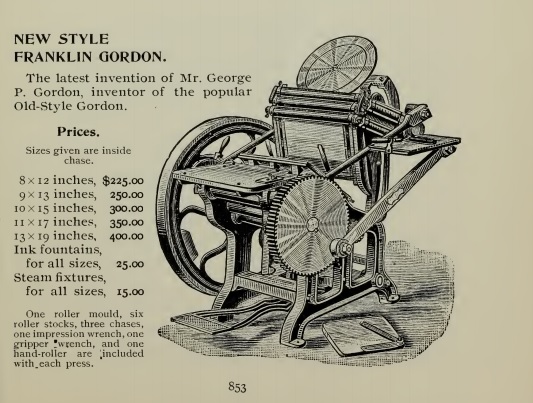 The New Style The New Style
Franklin Gordon Press
As stated in the advertisement, this was "the
latest invention of Mr. George F. Gordon" - the
latest style of press - and quite possibly the
last of his designs. Gordon presses were made by
license agreement in factories from NYC to
Chicago, San Francisco and Tokyo.
And, although H.H. Thorpe was influenced by
Gordon's general design, his rotation
platen-to-bed motion differs greatly from
Gordon's more "clamshell"-like impression
engineering approach.
C&P's Thorpe design soon eclipsed the
master's original - and quite popular press.
Gordon ceased building presses like this by
1900. C&P took over and dominated the market
for the next 50 years, bowing only to the
German-made Heidelberg Windmill which eventually
became the "must have" press for all letterpress
job shops.
An original
Franklin Gordon was recently discovered in
the basement of a home in New Jersey. The
woman's father had begun using it in 1948.
Soon, it will be put back into service in a
working letterpress museum and will be used
to pass on the skills of the craft to a new
generation of letterpress printers...
top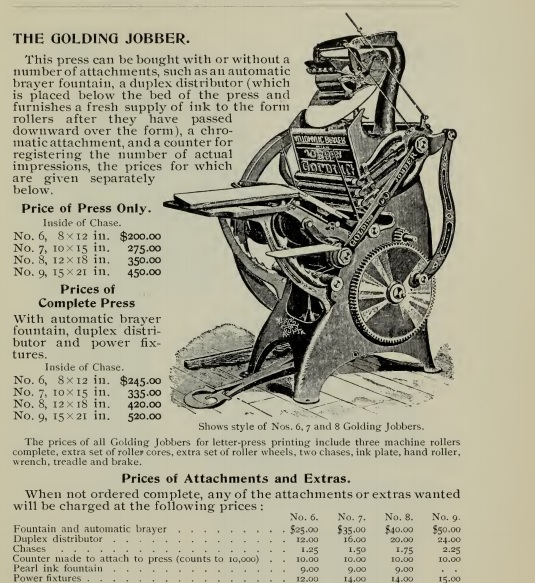 Golding
Job Presses brought a
new design to the
industry, employing a rotating platen on a
curved base that pushed the platen around from
the back using a totally different mechanism
than employed by any of the "Gordon style"
presses of the era. Golding
Job Presses brought a
new design to the
industry, employing a rotating platen on a
curved base that pushed the platen around from
the back using a totally different mechanism
than employed by any of the "Gordon style"
presses of the era.
The Golding Jobber was
the dominant heavy-duty general job press of its
day. Not as common as the C&P, but built
stronger and favored by many printers -
particularly the very large "Art Jobber" models
which came equipped with ink fountains and as
many as 6 rollers.
These presses came
in 4 sizes from 8x12 to 15x21 and were built to
withstand heavy use.
top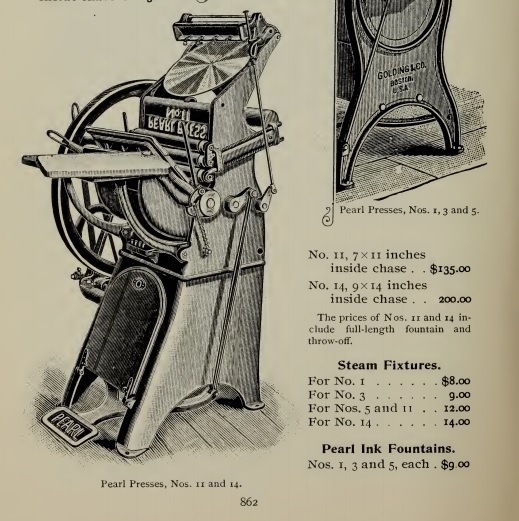 The Golding
Pearls The Golding
Pearls
Golding also made a
lighter-duty series of presses in sizes from 5x8
to 9x14. These presses were commonly treadle
driven and were touted as faster and easier to
use than other larger presses.
The did employ the same engineering as the
heavy-duty "jobbers", but were lighter and
faster to operate.
Early models did not have impression
throw-off levers on all sizes, but when the "New
Series" came along, all Pearls had this very
important safety feature.
These presses, along with the smaller
C&Ps have stood the test of time and are
still very popular, even though it's been more
than 100 years since they first went into
production. In 1927, ATF bought the rights to
the Pearl and continued to sell them for years
afterwards.
top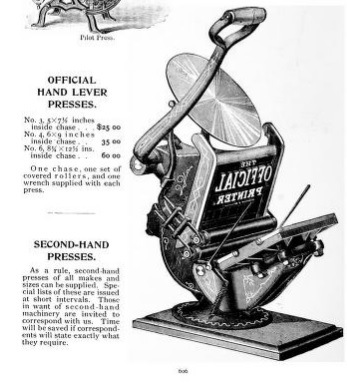 The
C&P Pilot - & the Golding Official The
C&P Pilot - & the Golding Official
Bench
Top Presses
C&P & Golding
also made high-quality, but inexpensive
bench-top presses for much lighter duty printing
and as teaching aids for just about all high
schools in the country. In fact, almost every
high school in America used Pilots to teach
their students the basics of platen press
printing before moving them on to the larger -
and more dangerous job presses (mostly C&P
Platens) that they would encounter when they
joined the trade as apprentices.
 The
C&P Pilot, like the job press, was designed
by H.H. Thorpe but rights were quickly acquired
by C&P, who actually sold parts to Thorpe
as he sold his presses as the Thorpe "Standard"
press for a few years after C&P bought the
patent rights. The Pilot was updated as the "New
Series" Pilot when C&P updated their entire
line around 1914. The
C&P Pilot, like the job press, was designed
by H.H. Thorpe but rights were quickly acquired
by C&P, who actually sold parts to Thorpe
as he sold his presses as the Thorpe "Standard"
press for a few years after C&P bought the
patent rights. The Pilot was updated as the "New
Series" Pilot when C&P updated their entire
line around 1914.
The Pilot has become arguably the most
sought-after bench top press in use today, with
some selling for as much as $4,000 when fully
restored to like-new condition - years after
many high school print shops (like my own)
tossed their Pilots into the dumpster - a tragic
loss.
Golding Officials, are one of the most beautiful
small presses ever made and when they can be
found, rate right up at the top, eclipsing the
more common Kelsey table top presses, which were
made at low cost to sell cheap - and actually as
a draw so that Kelsey Co. could sell them
printing supplies...
top of page
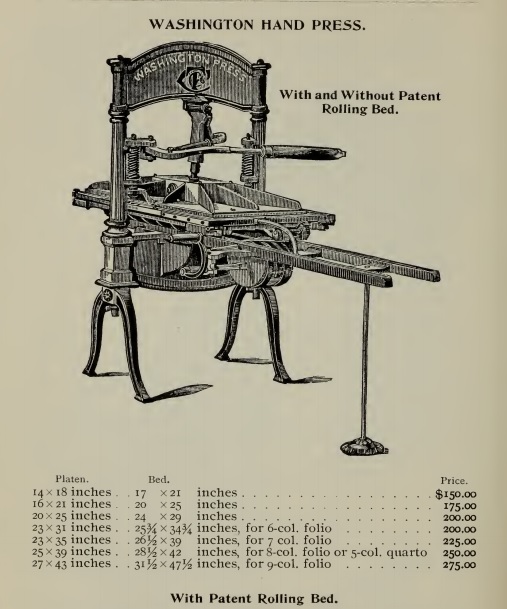 The Washington
Hand Press - The Washington
Hand Press -
By the early 1800's, the Wooden Common Press
began to be replaced by a variety of Iron Hand
Presses. It began with the Earl of Stanhope
Press around 1810 and ended with the Washington
Hand Press, built by Hoe & others from 1820
through at least 1906, when this press was
offered by the Cincinati Type Foundry, aka "CTF"
as can be seen cast into the frame of this
Washington. Although the presses were still
being built by CTF and Schneidewand & Lee
and others, these presses were commonly used as
proofing presses - specifically for
photo-engravers. The last of the Iron Hand
Presses lacked the full tympan & frisket
devices required for production work.
top of page
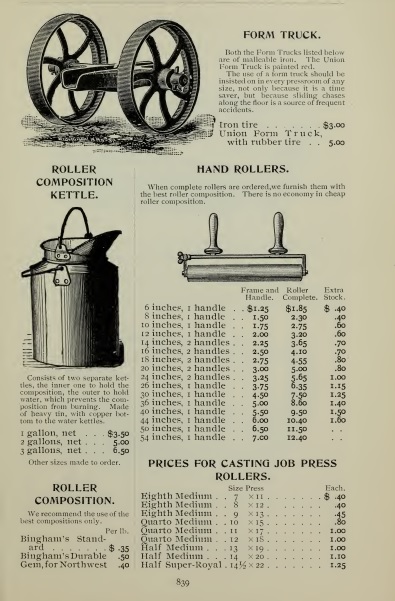 Other Pressroom
Items Other Pressroom
Items
There were many
other labor-saving items to be found in the
print shop of 1897. Here are a few of them...
The first one shown is the Form Truck. This
mini-dolly would hold a large locked up
chase/form on its edge and allow it to be rolled
anywhere it needed to be. Often, large forms
would be moved around on a "Turtle" - a
heavy-duty rolling table made by the Turtle
Company, but sometimes, this form truck would be
used instead.
The second item is the Composition Kettle. This
would be used to pour molten "composition" into
mold - generally supplied by the press maker.
The composition would cool in the molds and
produce a new set of rollers for the press. This
would often be done twice a year - once with
"Winter Composition" - which would be larger,
allowing for shrinkage in the cooler, drier
climate of the shop, while in the spring, the
printer would cast his "summer rollers" which
would be smaller in diameter, allowing for some
swelling in the hot, humid air of summer. These
presses often had two sets of trucks as well, to
be used with either size rollers, or to lighten
the impression when printing ruled forms.
Also on this page are the "inkers", aka
"brayers". Before presses had automatic inking
systems, and after the older Ink Balls went out
of use, the older style presses - like the
Wooden Common Press or the newer Washington Hand
Press would be hand-inked using these
wide-format hand inkers.
top of page |

